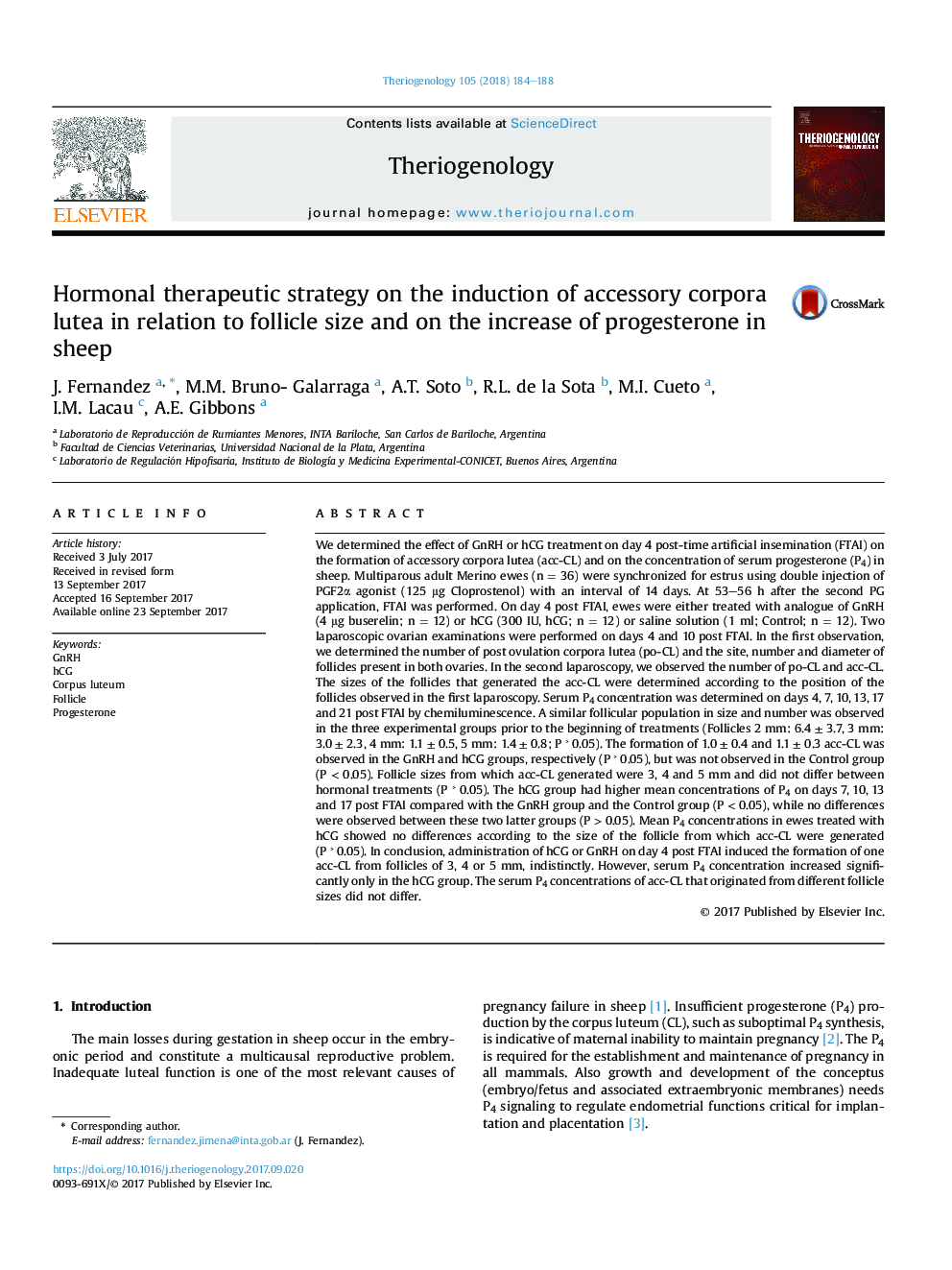| کد مقاله | کد نشریه | سال انتشار | مقاله انگلیسی | نسخه تمام متن |
|---|---|---|---|---|
| 5523033 | 1546064 | 2018 | 5 صفحه PDF | دانلود رایگان |
- The study assessed the effect of hCG or GnRH treatment on day 4 post-time artificial insemination.
- The effect was based on formation of accessory CL and concentration P4 serum.
- The numbers of accessory CL in response to GnRH and hCG treatments were positive.
- Concentration P4 serum increased significantly only in the hCG group.
- It is feasible to treat with hCG to generate accessory CL and increase P4
We determined the effect of GnRH or hCG treatment on day 4 post-time artificial insemination (FTAI) on the formation of accessory corpora lutea (acc-CL) and on the concentration of serum progesterone (P4) in sheep. Multiparous adult Merino ewes (n = 36) were synchronized for estrus using double injection of PGF2α agonist (125 μg Cloprostenol) with an interval of 14 days. At 53-56 h after the second PG application, FTAI was performed. On day 4 post FTAI, ewes were either treated with analogue of GnRH (4 μg buserelin; n = 12) or hCG (300 IU, hCG; n = 12) or saline solution (1 ml; Control; n = 12). Two laparoscopic ovarian examinations were performed on days 4 and 10 post FTAI. In the first observation, we determined the number of post ovulation corpora lutea (po-CL) and the site, number and diameter of follicles present in both ovaries. In the second laparoscopy, we observed the number of po-CL and acc-CL. The sizes of the follicles that generated the acc-CL were determined according to the position of the follicles observed in the first laparoscopy. Serum P4 concentration was determined on days 4, 7, 10, 13, 17 and 21 post FTAI by chemiluminescence. A similar follicular population in size and number was observed in the three experimental groups prior to the beginning of treatments (Follicles 2 mm: 6.4 ± 3.7, 3 mm: 3.0 ± 2.3, 4 mm: 1.1 ± 0.5, 5 mm: 1.4 ± 0.8; P Ë 0.05). The formation of 1.0 ± 0.4 and 1.1 ± 0.3 acc-CL was observed in the GnRH and hCG groups, respectively (P Ë 0.05), but was not observed in the Control group (P < 0.05). Follicle sizes from which acc-CL generated were 3, 4 and 5 mm and did not differ between hormonal treatments (P Ë 0.05). The hCG group had higher mean concentrations of P4 on days 7, 10, 13 and 17 post FTAI compared with the GnRH group and the Control group (P < 0.05), while no differences were observed between these two latter groups (P > 0.05). Mean P4 concentrations in ewes treated with hCG showed no differences according to the size of the follicle from which acc-CL were generated (P Ë 0.05). In conclusion, administration of hCG or GnRH on day 4 post FTAI induced the formation of one acc-CL from follicles of 3, 4 or 5 mm, indistinctly. However, serum P4 concentration increased significantly only in the hCG group. The serum P4 concentrations of acc-CL that originated from different follicle sizes did not differ.
Journal: Theriogenology - Volume 105, 1 January 2018, Pages 184-188
